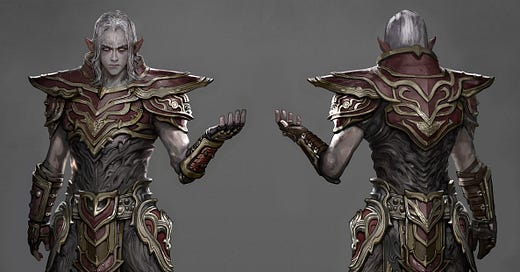Back in 2013, I started doing some freelance work for ArtBully Production.
80% of the work I have done up until now has been focused on props and weapons, ranging from cartoonish to realistic styles and from RPG to sci-fi genres.
Occasionally, I was assigned character design work, but it is not my specialty.
Unlike other concept artists who may have hundreds of character designs in their portfolios, I do not have many under my belt.
Sharing the Necromancer
The piece I am sharing today is a recent character design I created for the ArtBully Production Workshop. I must say this was a rich learning experience. Over the years, I have slowly learned what it really means to design.
In the context of designing, drawing or painting is not the end game; it is the means used to design something. You could not draw very well but still have good design ideas.
Strengthening one's ability to draw only increases the credibility of that design.
Illustration vs. Concept Art
In the piece I am sharing, there is a significant amount of time invested in the rendering, and that is the illustration part. The ornament shapes and various armor parts are clearly the design part, which is what concept design is about. Even though these small armor parts or shapes may be interesting, they are still part of the micro process of designing.
Art Direction
We may now zoom out and look at the design process from a macro perspective. This is where art direction comes into play with questions such as:
What is this necromancer going to look like? How can we create a necromancer that does not look like the thousands that are already oversaturating the internet?
The ArtBully art direction was to create something different, yet it must still remain relatable and identifiable as a necromancer. The white long hair, for example, is one characteristic often used for such characters that I decided to keep. However, I felt it was interesting to move away from the overused purple color in general.
Commonly used reference and market saturation
Most necromancers or similar characters in games like World of Warcraft rely heavily on the use of bones and skulls in the design to convey the idea of death.
This clearly conveys the point and offers a straightforward narrative, but it was something I wanted to move away from to add distinctiveness to this design.
A different approach
The ornaments and red areas alone do not necessarily convey death; they could very well be used for a non-necromancer character. However, their curvy lines and shapes convey an organic feel. This organic feel may trigger the idea that it is somewhat connected to the body and its functioning.
In a version I submitted to ArtBully, the gray areas, such as the abdomen and thighs a, were unclear or just made of gray fabric.
It might be one of the reasons the art direction suggested turning that gray area into an organic substance. From there, I was pointed toward some references from the Mass Effect alien race designs, which confirmed the new direction this character would take.
Overall Art Direction Style
I find this to be the best type of direction, a sort of dialogue and back-and-forth between what the designer considers valuable and the art director’s response, by toning down, amplifying, and sometimes building upon the artist's ideas to bring them to their full potential.
It is obviously not a unidirectional artistic influence but more clearly a dialogue.
Of course, that dialogue is not always possible if the art director's and artist's views are too far apart, but in this case, it seems to have worked out.
Personal Interpretation
I feel that design must encompass a bit of storytelling at the character level. The gray areas may give the feeling that part of the body is not human or is of a different nature or origin.
The character had to forgo or sacrifice part of his living body to substitute it with an organic but artificial organism to survive.
So his life may depend on the permanent integration of certain parts of the armor a bit like a zombie or let’s say Darth Vader, who would not be fully alive without parts of his body-integrated armor.
This means that this character had close encounters with death on the battlefield, recovered from it, and his body bears the permanent scars of the traumatizing experience of death, so much so that it becomes an embodiment of death on earth. No longer facing it, but expressing it, and that is what I call a Necromancer.
I am open to commission art. You can contact me here or through Upwork.





